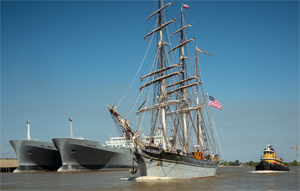In 1718, Jean-Baptiste Le Moyne de Bienville of the French Mississippi Company sailed up the Mississippi River and established La Nouvelle-Orleans, now New Orleans, the Crescent City.
Three hundred years later, on April 19, four tall ships made Algiers Point, the sharp bend in the river that forms the crescent, and docked along the Riverwalk at Woldenberg Park. They were, in order of appearance, the barque Picton Castle, the full-rigged Oliver Hazard Perry, the topsail schooner Oosterschelde and the barque Elissa.
The landing kicked off a weekend of festivities celebrating the city’s tricentennial, a highlight of NOLA Navy Week. It was also the last port of call, following Galveston, Texas, and Pensacola, Fla., in the 2018 Tall Ships Challenge on the Gulf Coast.
The visitors overcame extremely strong current due to heavy snowmelt by using their engines to go upriver. Crescent Towing of New Orleans provided two of its conventional tugboats, Port Hudson and Angus R. Cooper, to assist the ships as needed, and Cooper/T. Smith Mooring deployed hands on the docks to take lines and help secure the vessels.
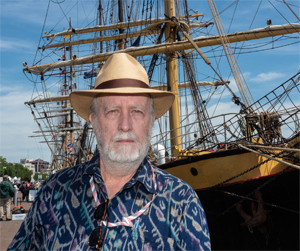 |
|
Capt. Daniel Moreland, shown on New Orleans’ Riverwalk, has more than three decades of experience as master or mate on tall ships. He has taken the barque Picton Castle on seven global circumnavigations. |
The Associated Branch Pilots of the Port of New Orleans (Bar Pilots) contributed their expertise to help the ships navigate from the sea buoy to Pilottown, La. Personnel from the Crescent River Port Pilots Association then guided the ships to their rendezvous at General Anchorage and on to New Orleans.
The first ship to round Algiers Point was Picton Castle, flying the flag of the Cook Islands.
“The tug crew were fantastic,” said Susie Ordway, chief mate on Picton Castle. “And the pilots were very helpful. They worked so well with the captain to ensure a safe navigation. Every part of the river has different eddies and currents, and you have to feel for how they are going to affect the ship. It’s all feel and experience.”
Based in Lunenburg, Nova Scotia, Picton Castle and its captain, Daniel Moreland, are noted in the tall ships fleet for global circumnavigations and other long voyages. The ship’s mission is deep-ocean sail training and long-distance education. After the tricentennial event, Picton Castle embarked on its seventh circumnavigation under Moreland’s command.
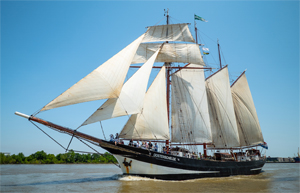 |
|
Oosterschelde arrives under sail for New Orleans’ tricentennial. The three-masted topsail schooner was launched in 1918 and underwent a four-year restoration in 1988. |
“The pilots were great guys, smart and competent, and the tugs were capable,” Moreland said. “It was a very interesting 130 miles with the current. We make 6.5 knots, but with a 4-knot current it was much slower.”
Picton Castle is a true working tall ship with a spar length of 179 feet and a rig height of 97 feet. Training classes include seamanship and navigation with plenty of opportunities to learn square-rig sailing. When sailing is not feasible, the ship’s 690-hp Burmeister & Wain diesel engine is engaged.
“Obviously the rig gets all the attention, but I’m just as proud of our engine room as I am of the rig,” Moreland said. “As well as training sailors, we train quite a few engineers.”
Moreland, with more than 30 years’ experience as master or mate on tall ships, holds the rarest license issued to merchant marine officers today: master of steam, motor, or auxiliary sail, vessels of any gross tons upon oceans.
The second tall ship to round the crescent was Oliver Hazard Perry. With a spar length of 196 feet, it is the largest civilian sailing school vessel in the United States, and the first full-rigged ship built in the U.S. in more than 100 years.
The ship is named for Commodore Oliver Hazard Perry, famous for his victories during the War of 1812 and his quote, “We have met the enemy and they are ours.” Oliver Hazard Perry Rhode Island is a nonprofit organization whose mission is to provide a platform for a wide range of sail-training and educational programs.
“It was really interesting and unusual seeing all the towns and industry coming up the river,” said E. Foretek, the second mate. “And I love all the commercial traffic. It is also an unusual body of water for us to navigate on. The pilots were great with their local knowledge. With the 4-knot current, the pilots set us into the eddies where the current was more favorable.”
Home-ported at Fort Adams near Middletown, R.I., the trainees on board participate in all of the tasks required to sail a full-rigged ship. The educational programs focus on leadership development, personal growth, team building, practical sail training, nautical academia and marine science.
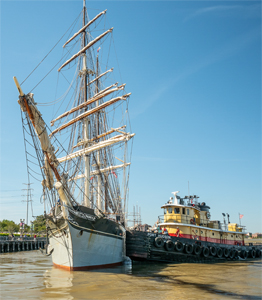 |
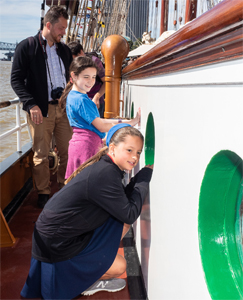 |
|
|
Crescent Towing’s Port Hudson, left, assists the tall ship Elissa to the dock. Another company tug, Angus R. Cooper, also was deployed to escort the quartet of tall ships up the Mississippi River to the Crescent City. Right, schoolchildren take a tour of Oosterschelde. |
||
The third ship to make Algiers Point, and the only one to arrive with sails set, was the three-masted topsail schooner Oosterschelde. Built in the Netherlands in 1918, the ship is the last representative of the large fleet of schooners that sailed under the Dutch flag at the beginning of the 20th century.
The ship, named for the east (oost) fork of the river Schelde, has a spar length of 164 feet and a rig height of 118 feet. Oosterschelde also sailed under the Danish and Swedish flags until 1988, when the Rotterdam Sailing Ship Foundation undertook an extensive and authentic restoration that was completed in 1992.
Prior to restoration, Oosterschelde earned its living as a cargo ship plying the oceans. Today, it serves as a sail education vessel and a floating embassy for its home port of Rotterdam. The ship has completed two circumnavigations and has visited more than 45 countries and five continents, including Antarctica.
Oosterschelde is fitted with a six-cylinder 450-hp John Deere diesel. Chief mate Jan-Willem Bos said the ship motored as it approached the river, but also was under partial sail because of favorable winds from the south that helped its speed from the sea buoy.
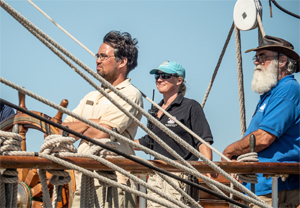 |
|
Crewmembers aboard Elissa on its Gulf Coast voyage in early 2018 included, from left, chief engineer Weston Hamilton, bosun’s mate Sarah Newman and assistant engineer Richard Michal. |
“We do 8 knots, so we calculated 30 hours from the sea buoy (to New Orleans),” he said. “But we had good pilots who knew the current and kept us close to shore (in the eddies), so we managed to get here a bit faster.”
From General Anchorage, the ship was under full sail “because people like to see them,” Bos said. “We set the sails whenever possible so they can enjoy them. And we had no problems. It was exciting making the corner (the crescent) under full sail, then into the wind to drop sails and maneuver to the dock without assistance from the tug.”
The fourth tall ship to sail into the Crescent City was the three-masted barque Elissa, the flagship of the Texas Seaport Museum in Galveston and one of the oldest sailing hulls still at sea.
“From the sea buoy we came in with the bar pilots, then we transferred to the Crescent pilots who provided us with local knowledge and their expertise on the river,” said Capt. John Svendsen. “It’s an incredible partnership when you bring a pilot on board. They know what the river is doing, they know the current, they know the bends. And they also speak the language of all the other vessels on the river. Their communication is vital to us. What we bring is the ship handling and the knowledge of this particular ship.”
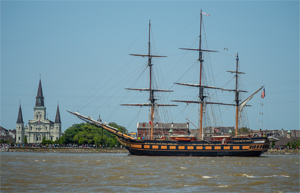 |
|
Oliver Hazard Perry passes St. Louis Cathedral on the New Orleans waterfront. Home-ported at Fort Adams in Rhode Island, it is the largest civilian sailing school vessel in the United States. |
Built in 1877 by Alexander Hall & Company of Aberdeen, Scotland, as a merchant vessel, Elissa entered service on the threshold of sail giving way to steam. The ship also sailed under different names for the flags of Norway, Sweden, Finland and Greece. In 1975, Elissa was rescued from a Greek scrapyard with a $40,000 check from the Galveston Historical Foundation.
Elissa made its first voyage as a restored sailing ship in 1985. The vessel’s spar length is 205 feet and its rig height is 110 feet.
“It’s a huge honor for us to get Elissa out of Galveston and get her out here at sea,” Svendsen said. “We just recently got a load line and a COI that allows us to sail in the Gulf of Mexico. When we were invited to the Gulf of Mexico Tall Ships Challenge, and particularly here to the tricentennial, we were very excited.”

